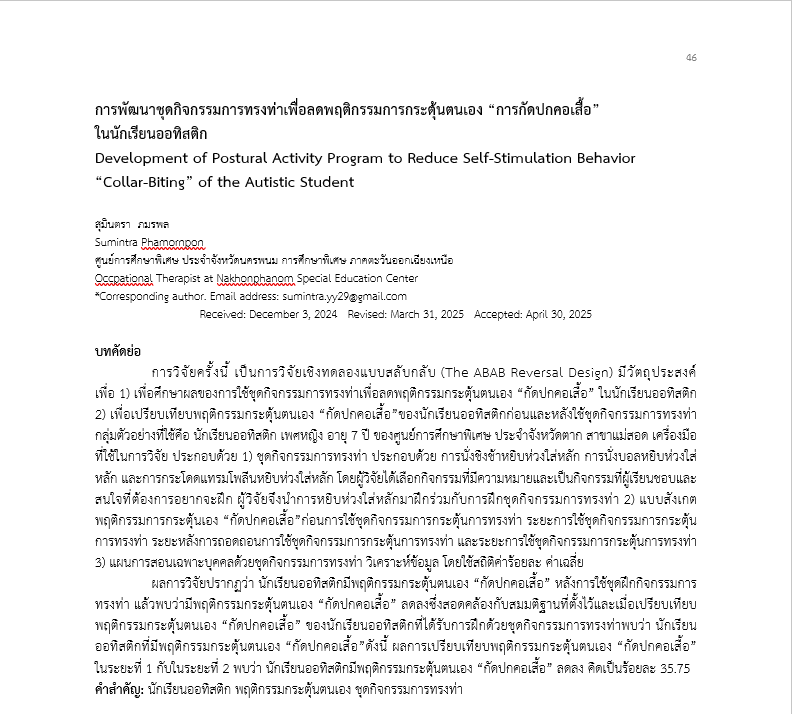Development of postural activity program to reduce self-stimulation behavior “Collar biting” in autistic student
Main Article Content
Abstract
This research is an ABAB Reversal Design. The objectives were to 1) study the effect of using a set of posture activities to reduce self-stimulating behavior, “collar-biting” of the autistic student, and 2) compare the self-stimulating behavior, “collar-biting” of the autistic student before and after using the set of posture activities. The sample was a 7-year-old female autistic student at Tak Special Education Center, Tak Province, Mae Sot Branch. The research instruments used consisted of 1) a set of posture activities, consisting of sitting on a swing, picking up a ring and putting it on a pole, sitting on a ball, picking up a ring and putting it on a pole, and jumping on a trampoline, picking up a ring and putting it on a pole. The researcher selected meaningful activities that the learners liked and were interested in practicing. Therefore, the researcher practiced picking up a ring and putting it on a pole together with the set of posture activities. 2) Observation form for self-stimulating behavior, “collar-biting” before using the set of posture stimulation activities, the period of using the set of posture stimulation activities, the period after removing the set of posture stimulation activities, and the period of using the set of posture stimulation activities. 3) Individual lesson plans with the set of posture activities. Data were analyzed using percentage and mean statistics.
The research results showed that the autistic student had self-stimulating behavior of “collar-biting” after using the posture training program. It was found that the self-stimulating behavior of “collar-biting” decreased, which was consistent with the hypothesis. When comparing the self-stimulating behavior of “collar-biting” of the autistic student who was trained with the posture training program, it was found that the autistic student had self-stimulating behavior of “collar-biting” as follows: the results of comparing the self-stimulating behavior of “collar-biting” in phase 1 and phase 2 found that the autistic student had self-stimulating behavior of “collar-biting” decreased by 35.75 percent.
Article Details

This work is licensed under a Creative Commons Attribution-NonCommercial-NoDerivatives 4.0 International License.
บทความที่ได้รับการตีพิมพ์เป็นลิขสิทธิ์ของวารสารครุศาสตร์ คณะครุศาสตร์ มหาวิทยาลัยนครพนม ข้อความที่ปรากฏในบทความแต่ละเรื่องในวารสารครุศาสตร์เล่มนี้เป็นความคิดเห็นส่วนตัวของผู้เขียนแต่ละท่านไม่เกี่ยวข้องกับมหาวิทยาลัยนครพนม และคณาจารย์ท่านอื่น ๆ ในมหาวิทยาลัยฯ แต่อย่างใด ความรับผิดชอบองค์ประกอบทั้งหมดของบทความแต่ละเรื่องเป็นของผู้เขียนแต่ละท่าน หากมีความผิดพลาดใด ๆ ผู้เขียนแต่ละท่านจะรับผิดชอบบทความของตนเองแต่ผู้เดียว
References
กรมสุขภาพจิต. (2562). คู่มือฝึกและดูแลเด็กออทิสติกสำหรับผู้ปกครอง (พิมพ์ครั้งที่ 2). กรุงเทพ ฯ: โรงพยาบาลยุวประ สาทไวทโยปถัมภ์.
เกริกชัย พิชัย. (2557). ผลของการใช้อาชาบำบัดลดภาวะกลัวการเคลื่อนไหวในแนวต้านแรงดึงดูดของโลกในเด็กออทิสติก. วารสารราชานุกูล, 29(1), 31-36.
ขวัญวรัชญ์ ชยาธรธนวัฒน์. (2557). ปัจจัยเชิงเหตุทางพุทธศาสนาที่มีความสัมพันธ์กับพฤติกรรมของผู้ปกครองในการดูแลเด็กออทิสติก : กรณีศึกษา สถาบันราชานุกูล. [วิทยานิพนธ์ ศิลปศาสตรมหาบัณฑิต] กรุงเทพฯ: มหาวิทยาลัยมหิดล.
ทวีศักดิ์ สิริรัตน์เรขา. (2561). คู่มือฝึกและดูแลเด็กออทิสติกสำหรับผู้ปกครอง (พิมพ์ครั้งที่ 2). กรุงเทพฯ: พรอสเพอรัสพลัส.
สถาบันราชานุกูล. (2557). เด็กออทิสติก คู่มือสำหรับพ่อแม่/ผู้ปกครอง (พิมพ์ครั้งที่ 3). กรุงเทพฯ: โรงพิมพ์ชุมนุมสหกรณ์ การเกษตรแห่งประเทศไทยจำกัด.
สรินยา ศรีเพชราวุธ. (2559). การทำกิจกรรมบำบัด Sensory Integration. [ระบบออนไลน์]. แหล่งที่มา http://web.kku.ac.th/autistic/th/images/stories/docandpdf/si.pdf. (1 เมษายน 2567)
สุภาพร ชินชัย. (2555). กรอบอ้างอิงการบรูณาการประสาทความรู้ สึก:ทฤษฎีและการปฏิบัติการทางคลินิกกิจกรรมบำบัด. เชียงใหม่: พิมพ์นานา.
Audet, L.R. (2001). The Nature of Pervasive Developmental Disorder: A Holistic View, in Autism: A Comprehensive Occupational Therapy Approach. Edited by H. Miller Kuhaneck. Bethesad: The American Occupational Therapy Asso


